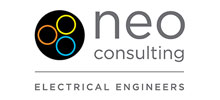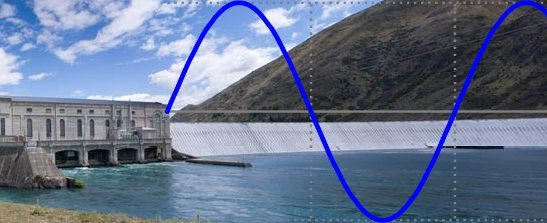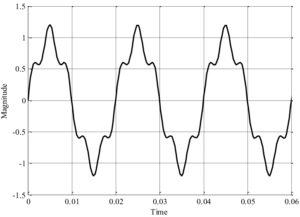Electricity generators produce a near pure 50 Hz sinusoidal waveform. Power quality can be defined as the ‘shape’ of the 50 Hz supply voltage and current waveforms. A distorted waveform is a symptom of poor power quality. A common cause of poor power quality is harmonics.
From variable speed drives (VSD) and uninterruptible power supplies (UPS) to LED lighting, electrical equipment installed on industrial sites are increasingly becoming harmonic emitters leading to poor power quality. Poor power quality can result in equipment failure and in extreme cases may result in the site being disconnected from the electricity network for non-compliance.
What are harmonics?
Harmonics are sinusoidal waveforms with frequencies that are integral multiples of the 50 Hz supply frequency. Harmonic waveforms distort the shape of the pure 50 Hz sinusoidal waveform. As electrical equipment is designed to work on a pure sinewave, a non-sinusoidal or distorted waveform can affect the operation of electrical equipment.
Figure 1 50Hz waveform with 5th harmonic distortion
Typical sources of harmonics in an industrial environment are VSD, UPS and switch mode power supplies. Regulations require equipment manufacturers limit harmonic emissions. However, the combination of devices typically found on an industrial site can often exceed harmonic distortion limits as set by the electricity lines company.
Should you be concerned about harmonics?
Installations with high levels of harmonics may experience issues such as:
- spurious equipment failure, issues with consumer electronics and computer equipment,
- overheating of transformer windings, motor windings and cables,
- overheating and failure of capacitors,
- nuisance tripping of circuit breakers,
- errors in instrumentation measurements,
- control systems not performing correctly.
The New Zealand Electricity Safety Regulations (ESR) require harmonic interference to be managed. Clause 31(2) of the ESR requires compliance with whichever of the following standards is applicable:
- NZECP 36 – New Zealand Electrical Code of Practice for Harmonic Levels
- IEC 61000-3-2 – Electromagnetic compatibility (EMC) – Part 3-2: Limits – Limits for harmonic current emissions (equipment input current ≤ 16 A per phase)
- IEC/TS 61000-3-4 – Electromagnetic compatibility (EMC) – Part 3-4: Limits – Limitation of emission of harmonic currents in low-voltage power supply systems for equipment with rated current greater than 16A
- IEC 6100-3-12 – Electromagnetic compatibility (EMC) – Part 3-12: Limits – Limits for harmonic currents produced by equipment connected to public low-voltage systems with input current >16A and ≤75A per phase
Ultimately the decision on which of these standards is applicable (and the harmonic limits required) is set by the electricity lines company responsible for the electrical connection.
For example, the Powerco Electricity Network Connection Standard requires that harmonics shall be managed in accordance with the Electricity Engineers’ Association (EEA) Power Quality Guidelines. With harmonic voltages and currents introduced not exceeding those specified in NZECP 36.
Electricity lines companies may require consumers with levels of harmonics outside their set limits to implement corrective measures at the consumers expense. In extreme cases, failure to do so could lead to disconnection.
The method for compliance checking should be agreed with the electricity lines company. An accurate power analyser should be used for measuring harmonics. A switchboard power meter is typically not suitable for confirming compliance.
What solutions are available?
There are many corrective measures available for harmonics including:
- Equipment level harmonic mitigation such as:
- AC or DC VSD chokes
- Low harmonic VSDs
- Passive filters
- Group level harmonic mitigation such as:
- Active harmonic filters
When planning a new installation or upgrading an existing installation your existing site performance should be measured and harmonic limits should be agreed with the electricity lines company. Following this a compliant cost-effective harmonic mitigation solution can be developed.
If you would like further information on how Neo Consulting can assist with assessing existing site performance and determining your harmonic mitigation requirements, please get in touch.
Matthew Watson
Electrical Engineer
d: +64 9 365 9743 | t: +64 9 365 9720 | m: +64 27 433 1752 | e: matthew.watson@neo.co.nz





















